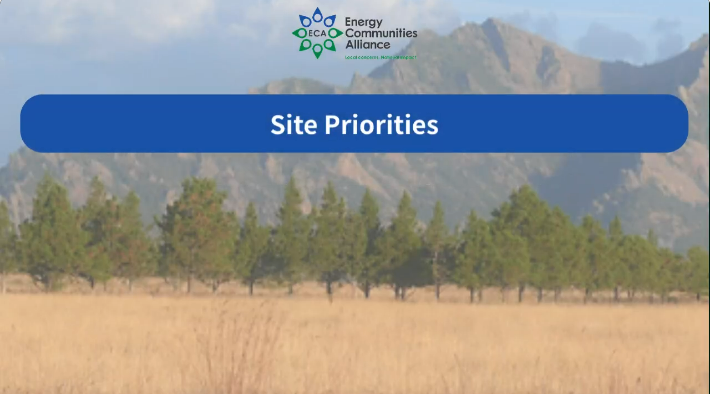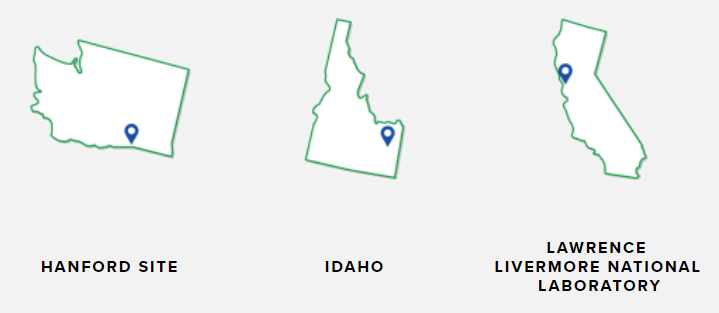SITE PRIORITIES
The foundation of any priority setting is understanding the adage that all politics are local. What works for one community, what has political support and is viewed as a local interest, might differ sharply from another community. The ability to adapt is particularly crucial for DOE as it must work with various communities that have unique political landscapes, technical risks, and potential future uses of the site.
AT A GLANCE
ECA’s Site Profile tool includes lists of priorities directly from the frontline communities that host each of EM’s sites.
FREQUENTLY ASKED QUESTIONS
-
Each party involved in a cleanup project has their own priorities. Priorities often vary in regards to the site condition upon DOE or regulatory agreement defined project completion (currently DOE calls these the “end-state”), and the steps to achieve the end-state (namely, what projects and activities are prioritized, and which are deferred to a later date). Across the DOE complex, end-state and future use priorities range from reducing risks and liabilities, to protecting or even expanding long-term job opportunities. Priorities can include maintaining a federal presence at one site or eliminating that presence at another, securing a new mission, redeveloping a portion of a site, or prohibiting reuse on all or parts of the federal site. These priorities must incorporate the communities’ goals, technical feasibility, cost, time and other issues.
State and federal cleanup requirements also impact cleanup priorities. See the sections on cleanup laws and regulations for further discussion.
As a community participates in shaping site priorities, the following can begin by considering:How can risks to the community and hotel costs be reduced?
What are the cleanup goals and what the parties are trying to achieve. For example, is there a defined future use for the site?
Is there a strategy for how to achieve the cleanup goals by integrating regulatory requirements, agency success criteria and orders, DNFSB recommendations, Congressional requirements and priorities, and local interests and priorities?
What are the options for future use of the site (sometimes called “end states”)?
-
In scoping complex environmental cleanups, determining end-state conditions and future use opportunities, the parties face a complex and daunting set of challenges and decisions. The specific questions the parties want to address can vary, but can be summarized by five overarching questions:
To what level should the site be remediated and why?
What opportunities will cleanup enable and prohibit?
How does cleanup support sustainable jobs?
What are the future use opportunities and goals?
How should the suite of activities be ordered?
-
Priorities change over time at a site. Budget, technology, state and federal agreements, accessibility to disposal sites, discovery of new contamination, changes in risk, can all impact cleanup priorities.
A good way to track DOE’s priorities at a site are through the annual DOE budget request. For each fiscal year, DOE submits requested amounts of funding for specific activities and projects at each site. Those activities can include cleanup, facility improvements, and security, but what is prioritized can change if new urgent cleanup arises, by Congressional direction, and it can change under new DOE or administration leadership. Additionally, each calendar year EM releases a “mission and priorities” document. Typically, the long-term priorities do not change much from year to year at a DOE site where cleanup has been on-going for decades, but opportunities, new discoveries of contamination, changes in budget allocation, and other issues can impact short-term implementation of the cleanup at the sites. Additionally, technological advances may require adjustments to priorities such as timelines and milestones. -
Local communities must take the initiative to organize and engage the federal government, the cleanup contractor, regulatory agencies, and Congress on cleanup. Through local community organizations at Hanford, Mound and Rocky Flats, for example, local governments created a forum to identify jointly their interests and develop strategies for accomplishing mutual goals. By working together, the communities were able to create “one voice” and amplify their shared priorities and better discern what is in the public interest. A local governmental entity can engage the federal government, the regulators and Congress on site issues, and can use the collective position of the local governments to better discern what is in the public interest.
ECA believes that local governments’ successes in representing their communities throughout the cleanup process are directly proportional to the time these community leaders engage with DOE at both the site and DOE headquarters. Additionally, communication with elected officials can ensure that the site is receiving adequate funding and/or policy responses if needed.
DOE can benefit from site managers’ regular communication with local government officials, which will ensure that DOE understands the local government’s perspective in each step of the cleanup process. For example, at most sites the DOE site manager meets with the City/County Manager or the regional organization of local governments monthly to prioritize site operations and coordinate goals. -
Changes in political leadership at DOE, in communities and states is an inevitable reality. Those changes may lead to different approaches in how local governments interact with DOE, contractors, and economic development entities. The changes can also bring new priorities and goals. ECA has seen this occur regularly at the DOE sites and headquarters. In some instances, new political appointees can lead to greater focus on specific issues such as environmental justice and climate change. In other instances, it may mean that the local government is requiring additional cleanup actions be taken at a site for protection of human health and the environment.
Regardless of individual politicians, the key to accomplishing cleanup goals is communication between the regulators, local government and DOE. Any discussion of the new or changed priorities will be key to fully understanding the impact of the change. Change can be difficult at DOE site cleanups that have been ongoing for a substantial period of time. Any shifts can mean hundreds of millions of dollars in increased or decreased costs and must be clearly articulated to the all parties affected by the cleanup.
ECA recommends that all local elected officials and decision-makers learn about and understand the history of their site, and the goals to be able to argue why DOE should change course in a cleanup action. -
Disagreement occurs regularly at DOE sites. Typically, DOE will continue its process as required by the regulatory cleanup agreement until any issues are resolved. The Congressional delegation for the community will likely be reticent about taking a side. All of the parties need to work together for a resolution.
There are many questions to consider when seeking resolution: Are there areas that can be negotiated or mitigated? Are there areas of agreement? In ECA’s experience, it can be helpful for local governments to bring in a third party to try to resolve the differences and negotiate an agreement.
ECA has also seen solutions to conflict addressed by the State stepping in to create a new regional organization that requires the parties to work together on the issues. For example, at the former Fort Ord, there was significant disagreement on the site cleanup and reuse of the site between the communities so the State of California created a coalition of local governments which assisted the parties to resolve their differences and work closely together over time. -
The active and consistent involvement of Congress in the cleanup process is central to DOE and the communities being able to claim a cleanup is successful. Congress provides funding through the annual appropriations process and provides oversight and sets policies through the annual National Defense Authorization Act. Congress, among its other roles, helps moderate discussions and improves the flow and effectiveness of the decision-making process. Toward this end, because the parties cannot effectively partner and negotiate without intimately understanding congressional politics, an effective partnership necessitates the active engagement of congressional staff in both Washington, D.C., and at the local level. Through this active engagement, the parties often are better able to remain aligned on the cleanup goals and mission, and Congress is better poised to support necessary action, such as appropriations or changes in law to facilitate the cleanup mission.
-
Federal sites are rarely remediated to natural background levels; consequently, contamination is usually left in place when cleanup is “complete.” Hence, the process of cleanup must recognize that ongoing management (or “long-term stewardship”) of the remaining contamination will be required. In order for these cleanup projects to remain assets for the affected community, the stewards must be identified and agreed to by all of the parties. They also need sufficient funding to implement long-term stewardship activities. Ideally, as remedies are chosen, long-term funding management requirements and funding needs will be identified as well. Learn more: Chapter 2, Politics of Cleanup.



